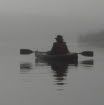This is one of those long wandering posts where I am writing mostly for my own benefit, for the discipline of stating things clearly, which requires me to think clearly.
Did I say that clearly?I finally woke up to the folly of slapping vinyl siding on our house. My Dad told me about a catastrophic fire in Edmonton that is believed to have spread through the vinyl exteriors of the houses. (For a discussion of this and other similar fires, see
this editorial.) Around the same time I stumbled across an
old discussion with CG where she called some houses "plastic monstrosities." Now you might think I am overreacting to a couple of people's comments, but what was my basis for choosing vinyl in the first place? Somebody's comments about "low maintenance," and somebody else's comment that steel siding makes a house look like a shed.
Why would steel siding make a house look like a shed? Because everybody's always done sheds that way, and houses a different way? I have to wonder. Industrial and agricultural buildings around here are overwhelmingly steel clad. In these utilitarian buildings, I would assume that they use steel because it works. So why not on a house? Don't we want houses that work?
But as I started overlaying blocks of colour on digital photos of our house, my resolve began to waver. What if I create a metal monstrosity? The colours look too strong. Is it worth the hours of fiddling to try to come up with a realistic image that includes shadows and different light levels and so on, to see what it will really look like? On the other hand, how do I know that vinyl would look any better?
The present siding on the original part of the house is concrete shingles in need of repair. Repair is a neglected "R." I came across a very interesting
article discussing the environmental, economic, and aesthetic merits of repair for traditional house materials such as wood siding and slate roofs, but I don't think that would apply to these shingles. They are quite unattractive to my eyes, sort of halfway pretending to look like wood. I think they'd look better if they didn't even try to look like anything other than thin flat slabs. Complicating the issue of repair is the possibility that these may contain asbestos. They have been painted, and the paint is peeling, but I don't want to start scraping them. So instead, we are planning to entomb the concrete shingles inside a thickened wall, thus turning them into a bit of thermal mass and giving us an opportunity to add more insulation outside them before adding the new siding.
And here I am back at the question of new siding. Shall I blaze a new trail, challenging the notion that steel siding is not for houses? At this point in the writing of this post, I turned aside to browse more sites about steel siding, since I had seen one for a U.S. company making steel siding that looks like clapboard - and I found a
Canadian company making similar steel siding that is
PVC coated. If you're choosing steel to avoid the toxic chemicals involved in vinyl production, you might want to know about that. Now I wonder. I don't even know what type of coating is on the steel we bought for the roof. So many questions! If I made sure to ask them all, I'd never get the house finished. Heck, I'd never even have got it started.
Deep breath. Why should steel siding be made to look like clapboard. It isn't clapboard, it's steel. Why shouldn't it look like itself?
And what about clapboard? Who says maintenance is evil? As that article I mentioned above points out, a zero-maintenance product is one that cannot be maintained, but must eventually be replaced. Which work and expense do you prefer, maintenance or replacement?
And then I get thinking about local materials. There's aspen. Does anyone make siding out of it? Perhaps
they should. Perhaps we should. Somebody around here must have a sawmill. But would we also need to find a kiln?
I recall that the wood panelling in the Mother Theresa Centre at Kenosee is aspen. Where did they get it?
All these questions make me tired. Maybe I'll fall back on the idea that came to me in the midst of all this: this house would look great covered in cedar shakes.
I mentioned the idea to my Dad, and we were right back to the beginning of all this: the fire hazard. But as Dad says, the house is fairly well separated from its neighbours. And then there are those concrete shingles in the wall, which would tend to keep a fire from going deeper.
Well now. Did I decide anything?
I could get all worked up about the ill-informed decisions I've been making all the way through this project, but instead I'll put it back in perspective. It seems hugely significant, and certainly there is a lot of work and expense and energy and environmental impact involved, but it doesn't happen every day. Things that do happen every day, like eating, might seem insignificant, but they're not. So if I fail to find the best information about building because I'm too busy learning to garden by gardening, well, so be it.
And I'm learning to build by building. When I finish learning this way, I'll have a finished house.
